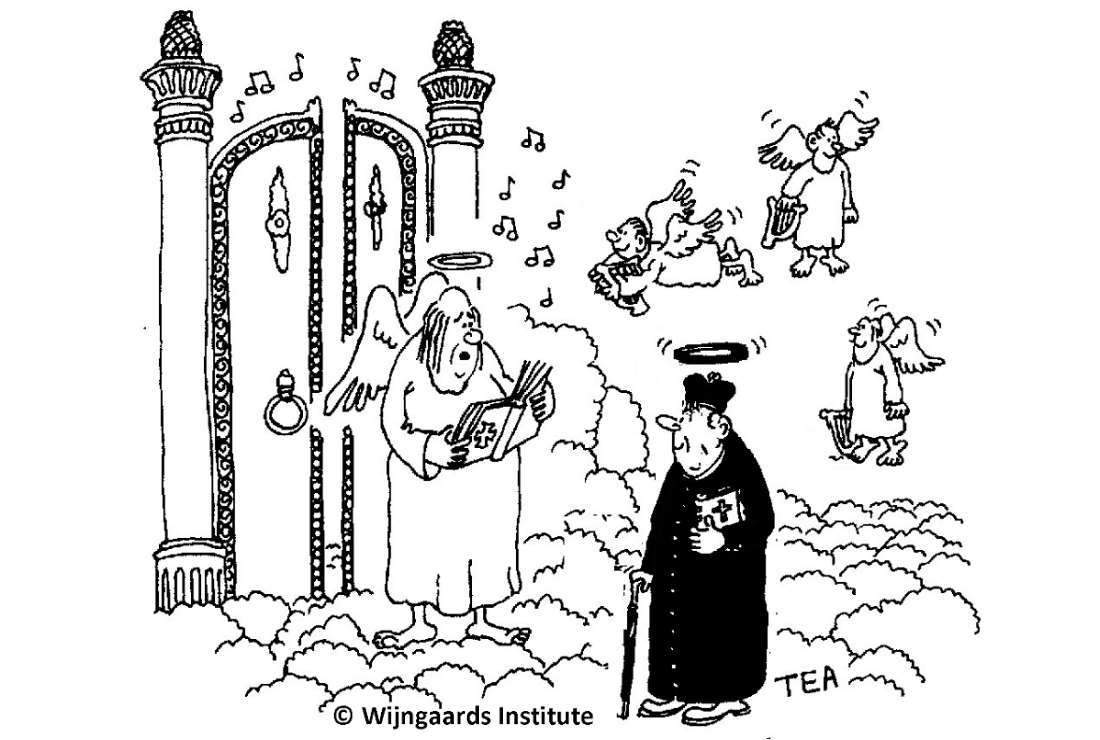Do we admit the necessity of introducing alterations in stages, like ordaining women as deacons before ordaining them as priests?

“Why couldn’t he go down one branch at a time?!” (Illustration: Tom Adcock)
“The kingdom of heaven is like yeast that a woman took and mixed into about sixty pounds of flour until it worked all through the dough” (Matthew 13,34).
The change of religious dress for sisters in India has been a drawn out, and at times turbulent, story. In the early 1980’s I was invited to give some lectures at a renewal seminar of a large Indian religious congregation. The meeting took place at the Mater Dei Institute in Old Goa. The participants were mainly local superiors of schools and convents.
I noticed that most sisters were wearing light brown saris, but some were still dressed in traditional white habits. I asked one of them, whom I shall call ‘Theresamma’ about this.
“Well”, she told me. “It’s a long story. We had inherited a medieval habit from Europe. After Vatican II, both practical reasons and cultural adaptation demanded a change, but there was much opposition. Many sisters themselves and their families considered the loss of the habit a reduction of status. Fortunately, we had a wise superior general who brought about reform in stages.”
“What stages?”, I asked.
“You won’t believe this”, she said. “The first stage was the abolition of the ‘chastity corset’. This was a short dress, from the waist down, that sisters were supposed to wear while having a bath or taking a shower. It was meant to save them from seeing their own naked underbody … Of course, it was ridiculous and unhygienic. It was dropped without too much opposition.”
“My goodness!”, I said.
“The second stage was to get rid of the headpiece, the so-called ‘coif’. This was an elaborate structure. It consisted of a white cotton cap secured by a strip across the forehead and a white ‘wimple’ to cover the neck and cheeks. Over all this hung a short cape of starched linen, known as a ‘guimpe’ which covered the top of the chest. The whole thing required that practically all hair was removed from the scalp. The coif was an abomination in the hot climate of India. I remember the relief when it was replaced by a simple veil. It also meant we could grow long hair again.”
“How liberating!”, I exclaimed.
“Indeed”, Theresamma replied. “And not too much opposition here either. That came with stage three. As you know, the traditional religious habit was a ‘tunic’ worn underneath with a ‘scapular’ on top of it, a kind of apron draped from the front and back. The whole was kept together by a belt, the so-called ‘cincture’. When, at one of our chapters, the superior general wanted for cultural reasons to replace this with an Indian-style sari, many sisters objected. Others applauded the move. The general showed her wisdom again by suggesting that adopting the sari would not be opposed as an obligation. Each sister could and can choose for herself.”
“Did it not lead to confusion?”, I asked.
“No, it didn’t. And, although it was a slow process, the sari is winning the contest. The number of sisters still wearing the old habit is dwindling rapidly!”
Working for reform
Many progressive thinkers in the Catholic Church are dreaming of massive changes. And for them, the sooner they happen the better. They believe that, after centuries of mismanagement in the Church, the way forward lies in boldly implementing a drastic programme of colossal reforms. One campaigner quoted Johann von Goethe at me, the nineteenth-century German statesman: “Boldness has genius, power and magic in it. Act now!”
Such campaigners overlook many key factors. It will take a considerable time to disentangle Church structures that have been used for centuries. They usually involve many elements: buildings, finances, established customs, specific jobs and tasks. But most of all they overlook the human factor.
People need time to adjust to a new reality. They have to fully grasp the reasons for change. They have to experience the advantages of a new system. Reform that is introduced too radically and too fast will totally alienate traditionalists and confuse the ordinary faithful in the middle.
What did Jesus think about all this?
Jesus recommends a gradual approach
Through some of his parables Jesus taught that the Christian faith would grow in steps. “The kingdom of heaven is like a mustard seed, which a man took and planted in his field. Though it is the smallest of all seeds, yet when it grows, it is the largest of garden plants and becomes a tree, so that the birds come and perch in its branches” (Matthew 13,31-32).
Even more telling is this: “The kingdom of heaven is like yeast that a woman took and mixed into about sixty pounds of flour until it worked all through the dough” (Matthew 13,34). Jesus refers here to a huge jar, as they have been found by archaeology, a jar that could contain 25 kilograms of flour. Just a small handful of yeast would slowly but surely leaven all the dough in one or two days’ time.
Jesus’ step-by-step approach is also well demonstrated in the way he gradually prepared Peter for his role as head of the apostolic twelve.
Jesus called Peter from his job as a fisherman (Mark 1,16-20). It was his home in Capernaum that Jesus visited when he cured Peter’s mother-in-law (Matthew 8,14). And it was Peter’s boat that Jesus used when he instructed the crowd (Luke 5,3). Peter asked Jesus for clarification of a parable (Matthew 15,15).
However, Peter could be unpredictable. One moment he displayed remarkable insight when proclaiming that Jesus was truly the Son of God (Matthew 16,15-18). Then, failing to understand what was really at stake, he rebuked his master when Jesus prophesied his suffering and death (Mark 8,32-33). And he requested Jesus for a special place in heaven as a reward for his faithful service (Matthew 19,27-28).
When Jesus was being interrogated in the high priest’s house, Peter let Jesus down, denying three times that he was one of Jesus’ disciples (Mark 14,66-72). He regretted it bitterly. Jesus responded, not by discarding Peter but by allowing him to be the first apostle to see him after the resurrection (Luke 22,31-32). And, in a final encounter at the lake of Galilee, he accepted Peter’s renewed commitment and entrusted him again with pastoral leadership over the disciples (John 21,15-17).
Questions
Are we prepared to accept a slow process of reforms? Do we realise that any changes in present Church ‘doctrines’ and practices will need to be accompanied by explanations, by a series of instructions that address both traditionalists and the body of the faithful?
Do we admit the necessity of introducing alterations in stages, like ordaining women as deacons before ordaining them as priests?
Published by arrangement with the Wijngaards Institute for Catholic Research
*The views expressed in this article are those of the author and do not necessarily reflect the official editorial position of UCA News.










